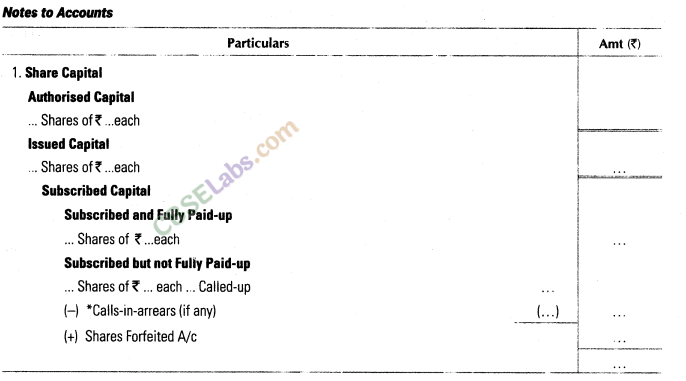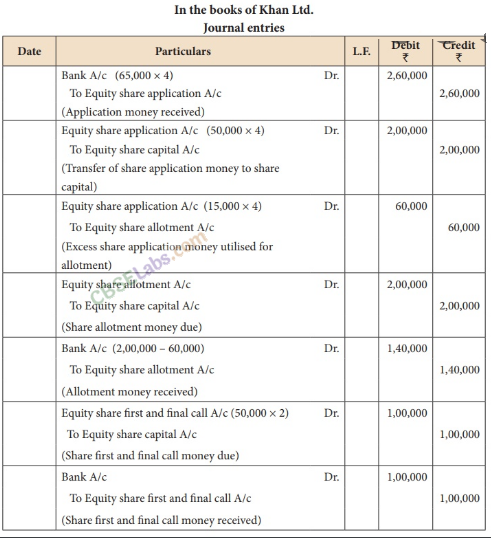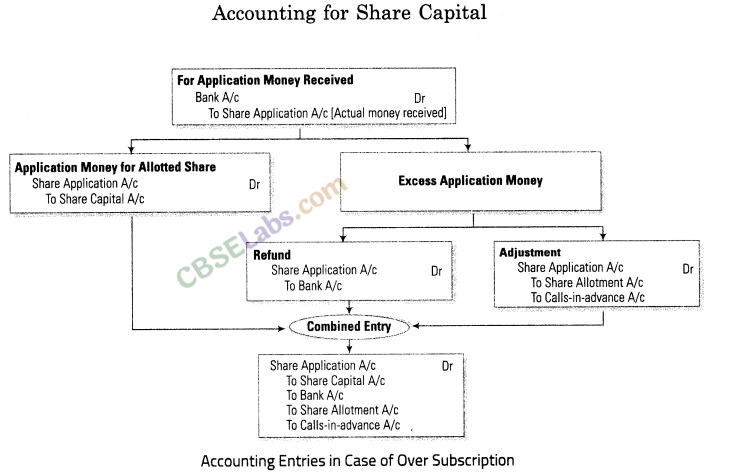Accounting for Share Capital – CBSE Notes for Class 12 Accountancy
Topic 1: Introduction
1. Company A joint stock company is an artificial person, created by law, having separate entity distinct from its members with a perpetual succession and a common seal.
2. Characteristics or Features of a Company
(i) Artificial person (ii) Voluntary association (iii) Created by law
(iv) Capital divisible into transferable shares (v) Limited liability
(vi) Perpetual succession (vii) Common seal
(viii) Separate legal entity from its members (ix) May sue or be sued
3. Kinds of Companies
(i) Private companies According to Section 2 (68) of the Companies Act, 2013, it is a company with minimum paid-up share capital of ^ 1,00,000 or such higher amount as may be prescribed in the Companies Act, 2013 and which by its Articles of Association
(a) Restricts the right to transfer its shares, if any.
(b) Except in one person company, limits the number of its members excluding its present and past employee members to 200; if the past or present employee acquired the shares while in employment and continue to hold them. If any share is held jointly by two or more persons, they shall be treated as a single member.
(c) Prohibits any invitation to the public to subscribe for any securities of the company.
The minimum number of members required to form a private company is two. The name of a private company ends with the words, ‘Private Limited’.
(ii) Public company As per Section 2 (7) of Companies Act, 2013, public company is a company which
(a) is not a private company.
(b) has minimum capital of Rs 5 lakh or such higher paid-up capital as may be prescribed.
(c) is a private company, which is a subsidiary of a public company. Minimum requirement of a public company is seven persons.
(iii) One person company is a company which has only one person as a member. It is a company incorporated as a private company which has only one member. Rule 3 of the Companies (Incorporation)
Rules, 2014 provides that:
(a) Only a natural person being an Indian citizen and resident in India can form one person company or can be nominee for the sole member of one person company.
(b) One person can form only one ‘one person company’ or become nominee of one such company.
(c) It cannot be formed for charitable purpose.
(d) It cannot carry out non-banking financial investment activities including investment in securities of any body corporate.
(e) Its paid-up share capital is not more than Rs 50 lakhs.
(f) Its average annual turnover should not exceed Rs 2 crores.
4. Share According to Section 2 (84) of the Companies Act, 2013, share means a share in the share capital of a company and includes stock. The capital of company is divided into a number of equal units. Each unit is called a share. A company may divide its capital into share of Rs 100, Rs 50, Rs 10, Rs 5 or even Rs 1 each.
5. Types of Shares
(i) Preference shares According to Section 43 (b) of the Companies Act, 2013, preference shares are the shares which carry the following two preferential rights:
(a) Preferential right of dividend to be paid as fixed amount or an amount calculated at a fixed rate, which may either be free of or subject to income tax.
(b) Return of capital on the winding up of the company before that of equity shares. Holders of preference shares are called preference shareholders.
(ii) Equity shares According to Section 43(a) of the Companies Act 2013, equity share is that share which is not a preference share. Equity shares are the most commonly issued class of shares which carry the maximum ‘risks and rewards’ of the business. The risks being losing part or all of the value of shares if the business incurs losses, the rewards being payment of higher dividends and appreciation in the market value.
6. Share Capital It is that part of the capital of a company, which is represented by the total nominal value of shares, which it has issued.
7. Kinds of Share Capital
(i) Authorised share capital According to Section 2(8) of Companies Act, 2013, ‘authorised capital’ or ‘nominal capital’ means such capital as is authorised by the memorandum of a company to be the maximum amount of share capital of a company.
(ii) Issued capital According to Section 2(50) of the Companies Act, 2013, issued capital means such capital as the company issues from time to time for subscription.
Subscribed capital According to Section 2(86) of the Companies Act, 2013, ‘subscribed capital’ means such part of the capital which is for the time being subscribed by the members of a company.
(a) Subscribed and fully paid-up Shares are said to be ‘subscribed and fully paid-up’ when the entire nominal (face) value is called and also paid-up by the shareholders.
(b) Subscribed but not fully paid-up Shares are said to be ‘subscribed but not fully paid-up’ when
• the company has called-up the entire nominal (face) value of the share but has not received it.
• the company has not called-up the entire nominal (face) value of share.
A reference has been made two terms
• Called-up capital According to Section 2(15) of the Companies Act, 2013, ‘called-up capital’ means such part of the capital, which has been called for payment. Thus, it means the amount of nominal (face) value called-up by the company to be paid by the shareholders towards the share capital.
• Paid-up share capital According to Section 2(64) of the Companies Act, 2013, ‘paid-up share capital’ or ‘share capital paid-up’ means the amount that the shareholder has paid and the company has received against the amount ‘called up’ against the shares towards share capital.
8. Reserve Capital It is that portion of uncalled share capital which shall not be capable of being called up except in the event and for the purpose of the company being wound up.
9. Capital Reserve ‘Capital reserve’ is the reserve which is not free for distribution as dividend. It is mandatory to create capital reserve in case of capital profits earned by the company. Reserves which are created out of capital profits are not readily available for distribution as dividend among the shareholders, e.g. premium on issue of shares of debentures, profits on re-issue of shares, profits prior to incorporation, premium on redemption of debentures.
10. Minimum Subscription It is the amount stated in the prospectus as the minimum amount that must be subscribed. Unless the sum payable on application for the sum so stated (minimum subscription) has been paid to and received by the company by cheque or other instruments, security cannot be allotted.
11. Presentation of Share Capital in Company’s Balance Sheet
As per Schedule III of Companies Act, 2013, share capital is to be disclosed in company’s balance sheet in the following manner


Topic 2: Accounting Treatment of Issue Shares
1. Terms of Issue of Shares
(i) Issue of shares at par When shares are issued at their face value, the shares are said to have been issued at par. i.e. issue price and face value are same.
(ii) Issue of shares at premium When shares are issued at a value that is higher than the face value of the shares, the shares are said to have been issued at premium, i.e. issue price is more than face value.
2. Utilisation of Securities Premium Reserve Section 52 (2) of the Companies Act, 2013 restrict the use of the amount received as premium on securities for the following purposes
(i) In purchasing its own shares (buy back) (Section 77A).
(ii) Issuing fully paid bonus shares to the members (Section 78).
(iii) Writing-off preliminary expenses of the company (Section 78).
(iv) Writing-off the expenses of, or the commission paid or discount allowed on any issue of securities or debentures of the company (Section 78).
(v) Providing for the premium payable on the redemption of any redeemable preference shares or of any debentures of the company (Section 78).
3. Accounting Treatment for Issue of Shares for Cash

4. Full Subscription of Shares When the number of shares applied for, is equal to the number of shares offered for subscription, the shares are said to be fully subscribed.
5. Over-Subscription of Shares When the number of shares applied for, is more than the number of shares offered for subscription, the shares are said to be oversubscribed. Allotment of shares cannot be made to all the applicants in full.
In case of over-subscription, following three alternatives are available (0 Rejection of applications (ii) Partial or pro-rata allotment (iii) Combination of pro-rata allotment and rejection

6. Under Subscription of Shares When the number of shares applied for, is less than the number of shares offered to the public, the shares are said to be under-subscribed.
7. Issue of Shares for Consideration other than Cash
I. Issue of Shares to Vendors
In this regard, the purchase of assets and issue of shares are to be treated as two separate transactions.
(i) (a) When Assets are Purchased
Assets A/c (Individually) Dr
To Vendor
(Being assets purchased from———-)
(b) When Business is Purchased
Sundry Assets A/c Dr
Goodwill A/c* Dr
To Sundry Liabilities A/c To Vendor
To Capital Reserve A/c*
(Being business purchased from vendor for purchase consideration of Rs——-)
NOTE
‘Vendor’ is credited with purchase consideration payable to him *Either goodwill or capital Reserve will come.
(ii) On Issue of Shares
(a) At Par Vendor
To Share Capital A/c
(b) At Premium Vendor
To Share Capital A/c To Securities Premium Reserve A/c
II. Issue of Shares to Promoters
Formation Expenses/ Incorporation Cost/Goodwill A/c Dr
To Share Capital A/c
(Being … share of Rs … each issued to promoters of the company)
III. Issue of Shares to Underwriters
(i) Making Underwriting Expenses Due
Underwriting Expenses A/c Dr
To Underwriters A/c (Being underwriting commission due)
(ii) Issuing Shares to Underwriters
Underwriters A/c Dr
To Share Capital A/c
(Being …shares issued @…….per share to underwriters)
8. Calls-in-arrears When one or more shareholders fail to pay their dues at the time of allotment or call, it is technically called calls-in-arrears.
Table F of the Companies Act, 2013, provides for the payment of interest on calls-in-arrears at a rate not exceeding 10% per annum.
9. Calls-in-advance The part of the whole amount received from the shareholders before the call is made, is called calls-in-advance.
This amount is shown on the liabilities side of the balance sheet as a separate item under the head ‘share capital’ but is not added to the amount of paid-up capital.
Table F of the Companies Act, 2013, provides for the payment of interest on calls-in-advance at a rate not exceeding 12% per annum.
10. Forfeiture of Shares
Forfeiture of shares means cancellation of shares and seizure of the amount already received from defaulting shareholders.
(i) Forfeiture of Shares Originally Issued at Par
Share Capital A/c Dr (Called-up money)
To Forfeited Shares A/c (Paid-up money)
To Share Unpaid Calls A/c (Unpaid money or calls-in-arrears)
(Being forfeiture of………….shares for non-payment of call of……….per share)
(ii) Forfeiture of Shares Originally Issued at Premium and Premium was Received
Share Capital A/c Dr (Called-up money)
To Forfeited Shares A/c (Paid-up money)
To Share Allotment A/c (Unpaid money excluding premium)
To Share Unpaid Call A/c (Unpaid money or calls-in-arrears)
(Being forfeiture of …… shares for non-payment
of allotment and call of…… per share)
(iii) Forfeiture of Shares Originally Issued at Premium and Premium was not Received
Share Capital A/c Dr (Called-up money)
Securities Premium Reserve A/c Dr (Unpaid premium)
To Forfeited Shares A/c (Paid-up money)
To Share Allotment A/c (Unpaid money including premium)
To Share Unpaid Call A/c (Unpaid money or calls-in-arrears)
(Being forfeiture of …… shares for non-payment
of allotment and call of ……per share)
11. Re-issue of Shares
The directors can either cancel or re-issue the forfeited shares. Shares forfeited can be re-issued at par, at premium or at a discount
In case, they are re-issued at par, accounting entry will be
Bank A/c Dr
To Share Capital A/c
In case, shares are re-issued at a discount, the amount of discount allowed on the re-issue of forfeited shares must not exceed the amount forfeited on re-issued shares. The discount allowed on re-issue of forfeited shares should be debited to the ‘share forfeiture account’. The journal entry will be
Bank A/c Dr [With the amount received on re-issue]
*Share Forfeiture A/c Dr [With the discount allowed on re-issue]
To Share Capital A/c [With the amount credited as paid-up]
*It is calculated as
Number of Shares Re-issued x (Paid-up Value – Re-issue Price Per Share)
If the forfeited shares are re-issued at a price higher than that paid-up, the excess is credited to securities premium reserve account. The journal entry will be
Bank A/c Dr
To Share Capital A/c To Securities Premium Reserve A/c
Transfer of Balance in Forfeited Share Account Forfeited Shares A/c Dr
To Capital Reserve A/c (Being balance of share forfeiture account transferred to capital reserve account)
CBSE Notes CBSE Notes Accountancy NCERT Solutions Accountancy